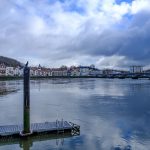Nestled close to the Southernmost border between Spain and France in the Basque area, Saint-Jean-de-Luz is a small city of some 15,000 inhabitant but with a big history. More about the history further on…
Saint-Jean-de-Luz is located South of Biarritz and on the Atlantic coast. It has a large and long beach, which is quite calm since the entrance to the beach enclave is dominated by big sea walls (and of course a fortress).
The city is pleasant, particularly if you like walking and discovering interesting buildings and streets. The inner city centre is pretty with compelling buildings.
The streets, many lined with outdoor terraces, vary between wide & spacious and narrow.
 Terraces and cafes along many of the streets in St-Jean-de-Luz
Terraces and cafes along many of the streets in St-Jean-de-Luz Popular square in St-Jean-de-Luz
Popular square in St-Jean-de-Luz Streets with shops and restaurants in St-Jean-de-Luz
Streets with shops and restaurants in St-Jean-de-Luz Narrow streets of Saint-Jean-de-Luz
Narrow streets of Saint-Jean-de-LuzBuildings
The buildings in Saint-Jean-de-Luz are not tall, 1 or 2 floors high; so no skyscrapers to mar the view. The houses and buildings are mostly “old” since the city escaped the horrors of WWII bombardments.
Here for example is the City Hall (in French “Mairie” or “Hotel de Ville“), a building built in 1656 in the shape of a “U”. Rumours has it that it was built in such a way to spoil a widow’s view of the harbour, a widow who rejected the romantic advances of the then Mayor:
 Saint-Jean-de-Luz City Hall (Mairie)
Saint-Jean-de-Luz City Hall (Mairie) Flag and bell at the St-Jean-de-Luz City Hall
Flag and bell at the St-Jean-de-Luz City HallThe widow, Maria Sol, lived in the house built in 1643 by her former husband and wealthy shipowner and buccaneer, Johannis de Lohobiague. The house, now called Maison Louis XIV, was renamed in 1660 to honor King Louis XIV (aka the “Sun King”) since the King had lived in this house for 40 days while negotiating a peace treaty with Spain to end a long and bloody war (more about that later on in this article):
 Maison Louis XIV in St-Jean-de-Luz
Maison Louis XIV in St-Jean-de-Luz Louis XIV sign on the Maison Louis XIV in St-Jean-de-Luz
Louis XIV sign on the Maison Louis XIV in St-Jean-de-LuzAnother special house is the “La Maison de l’Infante” named after Marie-Therese of Austria (who was the daughter of the King Philip IV of Spain… confused?), who was to be married to the King of France, who was his cousin. She stayed in this house in 1660 with the Queen Mother while the wedding was being prepared.
The house is now called “La Maison de l’Infante” (the House of the Infanta), but was built in 1640 by the Basque shipowner & buccaneer Joannot de Haraneder.
 Maison de l’Infante at St-Jean-de-Luz
Maison de l’Infante at St-Jean-de-Luz House sign of the Maison de l’Infante in St-Jean-de-Luz
House sign of the Maison de l’Infante in St-Jean-de-Luz House sign of the Maison de l’Infante in St-Jean-de-Luz
House sign of the Maison de l’Infante in St-Jean-de-LuzOther houses and buildings to be found (but not limited to)
 One of many old style houses in St-Jean-de-Luz
One of many old style houses in St-Jean-de-Luz One of many old style houses in St-Jean-de-Luz
One of many old style houses in St-Jean-de-Luz One of many old style houses in St-Jean-de-Luz
One of many old style houses in St-Jean-de-Luz Old fashion cinema in St-Jean-de-Luz
Old fashion cinema in St-Jean-de-LuzOne of the more important, and quite impressive, buildings to be found in Saint-Jean-de-Luz is the church; the Saint-Jean-Baptiste church.
 Saint-Jean-Baptiste church Altar in Saint-Jean-de-Luz
Saint-Jean-Baptiste church Altar in Saint-Jean-de-LuzClick here to read more about the church and its historic importance in one of our articles.
Fishing is an important part of Saint-Jean-de-Luz’s economy (next to tourism), so it’s no surprise that the harbour is packed with fishing boats. The harbour was used in previous centuries by corsairs (privateers or buccaneers, who were allowed to attack ships from other nations).
 Saint-Jean-de-Luz harbour
Saint-Jean-de-Luz harbour WWII memorial sign at the Saint-Jean-de-Luz harbour
WWII memorial sign at the Saint-Jean-de-Luz harbour Saint-Jean-de-Luz harbour
Saint-Jean-de-Luz harbourLike most places in France, there’s quite a large covered food market.
 The food market of Saint-Jean-de-Luz
The food market of Saint-Jean-de-Luz Inside the Saint-Jean-de-Luz food market
Inside the Saint-Jean-de-Luz food market Outside the Saint-Jean-de-Luz food market
Outside the Saint-Jean-de-Luz food marketOf course, like almost all covered food markets in France, it’s called “Les Halles”. But here you can find some nice and fresh food, many of the Basque cuisine traditions.
Waterfront
The beaches of Saint-Jean-de-Luz are very much favoured by beachgoers in France. The reason for that is the sea walls that protect the city and harbour. Not only did they protect the city from raiding pirates and storms, but also make sure that water is calm for bathers.
Alongside the houses next to the beach is a tall and wide sea dyke. The dyke itself is also the promenade, allowing people to walk the length of the beach without getting sand in their shoes.
 Dykes next to the Saint-Jean-de-Luz beach
Dykes next to the Saint-Jean-de-Luz beach Long beach of Saint-Jean-de-Luz. On the outer side you can see the sea wall
Long beach of Saint-Jean-de-Luz. On the outer side you can see the sea wall Beach area close to the city of Saint-Jean-de-Luz
Beach area close to the city of Saint-Jean-de-Luz Beach area close to the city of Saint-Jean-de-Luz
Beach area close to the city of Saint-Jean-de-Luz Spas alongside the Saint-Jean-de-Luz beach
Spas alongside the Saint-Jean-de-Luz beachAt the end of the sea walls, protecting the city from storms and raiders is a fortress called the “Fort de Socoa“. It’s not part of Saint-Jean-de-Luz but belongs to the neighbouring town of Ciboure.
 Fort of Socoa of Cibourne next to Saint-Jean-de-Luz
Fort of Socoa of Cibourne next to Saint-Jean-de-Luz Part of the sea walls of Cibourne / Saint-Jean-de-Luz
Part of the sea walls of Cibourne / Saint-Jean-de-Luz Part of the sea walls of Cibourne / Saint-Jean-de-Luz
Part of the sea walls of Cibourne / Saint-Jean-de-Luz Small chapel on the cliff next to the sea walls of Cibourne / Saint-Jean-de-Luz
Small chapel on the cliff next to the sea walls of Cibourne / Saint-Jean-de-LuzSummary
Saint-Jean-de-Luz is a very nice place to visit and stay. It has been so for centuries. People tend to choose between Biarritz and Saint-Jean-de-Luz for their summer holidays, and when King Louis XIV came here, the city became a “must be seen” places for the gentry.
If you are into beaches, this is a great place to be thanks to the great climate and calm water.
Related Posts
- 10000
 The Saint-Jean-Baptiste Church in Saint-Jean-de-Luz is a special church, both in beauty and historic importance. The first mentions of this church were already found in the 12th century, however, the real construction of the church was in the 15th century. The church is located, like most churches, quite in the…
The Saint-Jean-Baptiste Church in Saint-Jean-de-Luz is a special church, both in beauty and historic importance. The first mentions of this church were already found in the 12th century, however, the real construction of the church was in the 15th century. The church is located, like most churches, quite in the… - 10000
 Transport Getting there Air: There is no airport at Saint-Jean-de-Luz, but the Biarritz/Bayonne airport is 20 minutes away. Ferry: There are no ferries operating to Saint-Jean-de-Luz. The closest city that offers international ferries is Bilbao, Spain. Within Saint-Jean-de-Luz The city is flat, with narrow streets. So you'll not find an…
Transport Getting there Air: There is no airport at Saint-Jean-de-Luz, but the Biarritz/Bayonne airport is 20 minutes away. Ferry: There are no ferries operating to Saint-Jean-de-Luz. The closest city that offers international ferries is Bilbao, Spain. Within Saint-Jean-de-Luz The city is flat, with narrow streets. So you'll not find an… - 10000
- 10000


